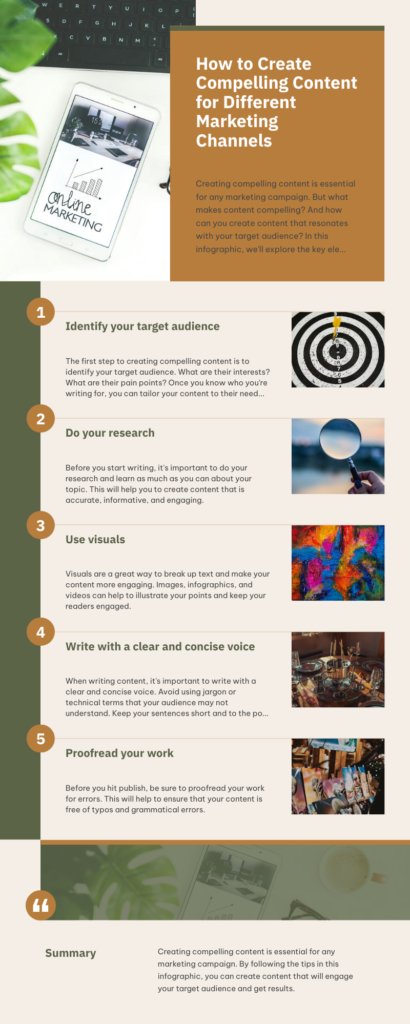Creating compelling content is key to reaching and engaging your target audience across platforms. However, the type of content that resonates can vary greatly depending on the marketing channel. In this article, we’ll explore top strategies for developing standout content tailored to 5 of the most popular digital marketing channels – blogs, social media, email, PPC ads, and landing pages.

Craft Content that Connects on Blogs
Blogs allow you to dive deeper into topics and position your brand as an industry thought leader. Follow these tips for blog posts that captivate readers:
Choose subjects strategically – Analyze site metrics and customer data to identify knowledge gaps and questions your audience has. Blog content should help them solve problems.
Introduce variety – Incorporate different formats like step-by-step tutorials, detailed guides, list posts, Q&As, case studies, and interviews. Different styles appeal to different learning preferences.
Get personal – Develop an authentic authorial voice and share your experiences. Inviting some personality into posts forges stronger connections with readers.
Optimize for SEO – Research keywords using Google’s Keyword Planner and organically work them into headings and body text. This amplifies reach.
Include visual assets – Relevant images, graphics, charts, videos, and gifs visually engage visitors and make dense information more digestible.
Promote sharing – Include social media sharing buttons prominently so readers can easily distribute posts they find valuable.
Review and repurpose top-performing blogs – Look back at previous high-traffic posts and update them or create new content that covers those popular subjects from a different angle.

Spark Engagement on Social Media
With billions of active users, social platforms present massive opportunities to converse with your audience. Here are social media content strategies to spark greater engagement:
Align content to platform strengths – Post short tweets for scannability on Twitter, inspirational lifestyle images on Instagram, behind-the-scenes company videos on Facebook, and helpful “how-to” clips on YouTube tailored to features of each channel.
Coordinate cross-channel campaigns – Develop unified content pieces, hashtags, and publishing schedules across your brand’s social media accounts around events, promotions, and big announcements for consistency and higher visibility.
Cater to mobile – Over 50% of social media consumption now happens on mobile devices. Optimize video lengths, image sizes, link formats, and text density so content displays readably on tiny screens.
Incentivize shares and tags – Request readers tag a friend who would find your post helpful or share it with their networks to be entered into a giveaway contest. This expands your organic reach exponentially.
Monitor and respond – Track audience responses and emerging trends using social media analytics tools. Post replies addressing questions, concerns, feedback, and commentary to foster greater interactivity with your community.

Email for Lasting Impressions
Email provides a direct line for developing loyal, trusting relationships with subscribers over sustained touchpoints. Make your messages stand out in crowded inboxes with these email content tips:
Personalize subject lines – Trigger open rates by dynamically inserting first names, locations, companies, and other subscriber details culled from CRM systems into subject lines so messages feel individually tailored.
Segment lists – Group contacts by attributes like demographics, interests, and purchase history to align email content specifically to different target personas based on granular insights into their needs/preferences.
Embed calls-to-action – Every email should have a strategic purpose, whether driving an immediate sale, promoting a new offering, or nudging towards the next step in the conversion funnel. Place colorful, contrasting CTA buttons in body text or banners at the top/bottom to motivate reader actions.
Feature customer testimonials – Publish enthusiastic verified reviews from past buyers discussing their experience with your company. These credible stories build trust while subtly highlighting your brand’s strengths.
Update legacy subscribers – If publishing time lapses between messages grow too long, old emails risk seeming irrelevant or even annoying subscribers. Refresh their memory on who you are, value provided, and why they signed up originally before diving into new content.

Seduce Searchers with PPC Ads
Pay-per-click ads distill your offerings into fleeting but compelling text/visual bite sized pitches. Follow these pointers for PPC ads that persuade searchers to click and convert:
Lead with benefits – Orient ad copy around tangible outcomes – increased productivity, reliability, or status – instead of generic features to pique visitor interest straight away.
Leverage emotional appeals – Complement rational advantages with feelings of enjoyment, confidence, acceptance, or being part of an aspirational lifestyle associated with your offering by using subtly suggestive language and imagery. This subconsciously sways purchase decisions.
Speak to intent – Study search query data to discern purchase timelines, commercial/informational needs, and context behind user intentions. Reflect their current mindset in phrasing and features emphasized. Someone searching “honda dealers” needs different messaging than a searcher querying “how to save money fast.”
Direct eyes with visual hierarchy – Apply contrast, color, size, and text bolding purposefully so the eye gets drawn towards your CTA button first before absorbing the rest of the ad.
Split test relentlessly – Continually test combinations of ad elements like headlines, descriptions, display URLs, calls to action, layouts, images, and targeting to accumulate learnings on what permutations deliver optimal click and conversion rates.

Land Visitors with High-Impact Pages
Landing pages distill your brand’s offerings into a singular compelling promise aligned tightly to each campaign. Perfect their content presentation with these tips:
Begin with the benefit – Welcome visitors instantly with a hard-hitting headline and subheadline prominently positioned at the top telegraphing the exact advantage they gain working with you.
Spotlight proof – Display trust symbols like security badges, client logos, testimonials, press mentions, and certifications prominently to establish credibility quickly.
Reduce obstacles – Eliminate unnecessary navigation links as distractions and provide crystal clear next steps via clickable buttons or contact forms to seamlessly guide visitors along conversion funnels tailored to campaign goals.
Interrupt patterns – Deviate from template site styles with contrasting layouts, fonts, more generous white space, and brighter accent colors specifically on landing pages to capture wandering attention used to skimming over repetitious interfaces.

While channels may differ greatly, compelling content remains the common thread tying together integrated digital marketing strategies. Always optimize assets around addressing your audience’s pressing needs first with valuable solutions before ever pushing product features for the best response across blogs, social media, email, PPC, and dedicated landing pages. Let the above guide spur ideas for irresistible content tailored to the unique particularities of each medium your brand leverages to reach customers.






